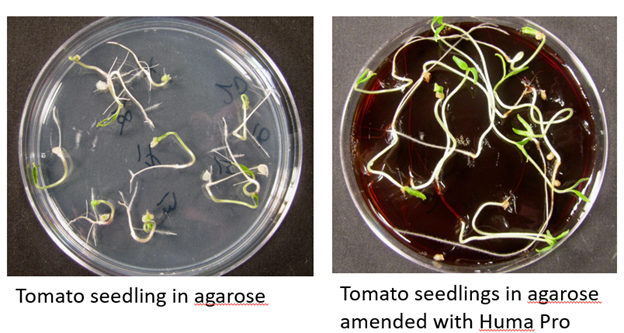Huma Pro® Stimulates Rhizophagy Cycle of Microbes to Increase Root Growth, Rutgers Univ.
Conducted by: James White, PhD, Rutgers University
Huma Gro® Products: Huma Pro®

The purpose of this research project was to evaluate how humic acids stimulate microbial activity and initiation of the rhizophagy cycle (in which plants cultivate microbes on their roots and then absorb them to extract their nutrients). Huma Gro® Huma Pro®, a liquid 6% humic acid product, was used as the humic acid biostimulant source.
MATERIALS AND METHODS
Huma Pro®, a 6% liquid humic acid, was incorporated into agarose at concentrations of 0%, 0.01%, and 0.10% humic acids. Seeds of tall fescure, annual bluegrass (Poa annua), and beefsteak tomato were surface disinfected in 3% NaOCl for 30 minutes to reduce microbial load on seedlings. Seeds were germinated and grown for 6 days on agarose (a polysaccharide derived from seaweed) with and without the Huma Gro® product.
CONCLUSIONS
Huma Pro® promotes seedling development in the seedlings tested. Root length in seedlings treated with Huma Pro® increased 73% (tomato) to almost 300% (tall fescue), roots growing downward increased 7 percentage points (tomato) to almost 75 percentage points (bluegrass), and shoot length increased 80% for tall fescue. Huma Pro® acts to stimulate the root microbiome and shows evidence of stimulating the rhizophagy cycle. Stimulation of the rhizophagy cycle in plants should result in increased nutrient absorption in plants.
Click HERE to read the full report.
Related Posts

Video: BHN Company Values
In this 4-minute video, BHN President/CEO Lyndon Smith speaks with us about BHN’s Company Values—Integrity, Win-Win-Win, Proactive Innovation, Relentless Pursuit of Excellence—and their impact on how we conduct business, treat our customers, and benefit the world.

This Week in Ag #14
You never get a second chance to make a first impression. That popular saying could just as easily apply to planting corn. It’s impossible to recover from planting time mishaps. Don’t believe it? Try this. Walk into a cornfield where plants have recently emerged. Identify a plant that’s shorter than the rest (some call these

This Week in Ag #32
Everyone remembers where they were on September 11, 2001. One of my most vivid memories was the week after. I was farming with my dad at the time. He had just started cutting soybeans in a field owned by my wife’s family, situated next to Interstate 74 in western Illinois. I was driving to the

